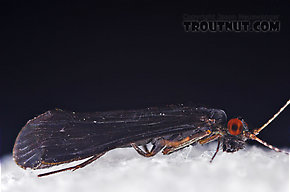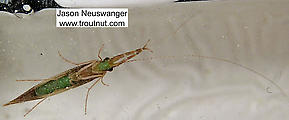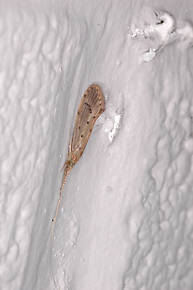Blog & Latest Updates
Fly Fishing Articles
Insects by Common Name


Caddisfly Family Leptoceridae
Taxonomic Navigation -?-
Kingdom
Animalia (Animals)
» Phylum
Arthropoda (Arthropods)
» Class
Insecta (Insects)
» Order
Trichoptera (Caddisflies)
» Family Leptoceridae
| Genus in Leptoceridae | ||
| CeracleaScaly-Wing Sedges | 0 | 0 |
| Leptocerus | 0 | 0 |
| MystacidesBlack Dancers | 4 | 18 |
| NectopsycheWhite Millers | 1 | 1 |
| OecetisLong Horn Sedges | 2 | 2 |
| Triaenodes | 1 | 4 |
2 genera aren't included.
Hatching Behavior
Time Of Day (?): Usually afternoon or evening, except for Mystacides (morning) and Nectopsyche (nighttime)
The pupae emerge on the surface.Egg-Laying Behavior
Females may fall spent (Spent: The wing position of many aquatic insects when they fall on the water after mating. The wings of both sides lay flat on the water. The word may be used to describe insects with their wings in that position, as well as the position itself.) on the surface to lay their eggs or dive to the bottom, depending on the species.
Larva & Pupa Biology
Diet: Wide variety, depending on species: may be insects, sponges, detritus (Detritus: Small, loose pieces of decaying organic matter underwater.).
Shelter Type: Cases of various debris, or just silk
Leptoceridae Fly Fishing Tips
The females of this family are smaller than the males, so imitations of egg-layers should approximate the smaller adults.
Pictures of 12 Caddisfly Specimens in the Family Leptoceridae:
Male Mystacides sepulchralis (Black Dancer) Caddisfly Adult View 10 PicturesThis was one of many of its species which were gathered in small, low-flying swarms of about a dozen insects near the alder trees in the afternoon on a small stream.
View 10 PicturesThis was one of many of its species which were gathered in small, low-flying swarms of about a dozen insects near the alder trees in the afternoon on a small stream.
 View 10 PicturesThis was one of many of its species which were gathered in small, low-flying swarms of about a dozen insects near the alder trees in the afternoon on a small stream.
View 10 PicturesThis was one of many of its species which were gathered in small, low-flying swarms of about a dozen insects near the alder trees in the afternoon on a small stream.Collected August 22, 2006 from the West Branch of Owego Creek in New York
Added to Troutnut.com by Troutnut on August 23, 2006
Added to Troutnut.com by Troutnut on August 23, 2006
Triaenodes Caddisfly Adult View 4 Pictures
View 4 Pictures
 View 4 Pictures
View 4 PicturesCollected August 7, 2004 from unknown in Wisconsin
Added to Troutnut.com by Troutnut on January 25, 2006
Added to Troutnut.com by Troutnut on January 25, 2006
Oecetis avara (Tan Spotted-Wing Long-Horned Sedge) Caddisfly Adult View 1 Pictures
View 1 Pictures
 View 1 Pictures
View 1 PicturesCollected July 10, 2005 from the Flathead River-lower in Montana
Added to Troutnut.com by Bnewell on June 30, 2011
Added to Troutnut.com by Bnewell on June 30, 2011
Recent Discussions of Leptoceridae
Moved from genus level to N. albida
Posted by Entoman on Jun 15, 2014 in the species Nectopsyche albida
It is my understanding that wing maculation is quite distinctive and consistent in this genus thus allowing species identification using this character. This specimen has been at the genus level for many years and somehow slipped through the cracks.;)
ReplyWhite Miller Bug 3 Replies »Posted by MIKE54 on May 3, 2013 in the species Nectopsyche albida
Last reply on May 4, 2013 by Adirman
Where did the name "White Miller" come from, for the caddis bug in the warm Yellowstone waters? I am not interested in the east coast mayfly with the same name. Thanks, Mike Miller.
ReplyDoes anyone have success fishing this hatch? 9 Replies »Posted by Troutnut on Sep 24, 2006 in the genus Mystacides
Last reply on Jan 14, 2011 by PaulRoberts
I've been extremely frustrated several times by trout feeding on Black Dancers, especially on the Brule in Wisconsin. The flies gather in little swarms beneath overhanging alders along the bank, usually within a foot or two of the surface, and "dance" around. A trout or two, usually small, will appear below them and rise steadily.
This is one of the most reliable insect activities on that river in the summer. It's quite unlike any other hatch, since it never affects most of the stream. Instead, there are just little pockets of activity here and there along the bank. It would be interesting to see if some of the trout are Mystacides "specialists" who are conditioned to cruise the banks looking for this food source.
At any rate, I've never had much luck catching these trout. I've tried most often on the Brule but I've run across similar situations on Finger Lakes and Catskill rivers in New York, too. Has anyone cracked the code?
ReplyThis is one of the most reliable insect activities on that river in the summer. It's quite unlike any other hatch, since it never affects most of the stream. Instead, there are just little pockets of activity here and there along the bank. It would be interesting to see if some of the trout are Mystacides "specialists" who are conditioned to cruise the banks looking for this food source.
At any rate, I've never had much luck catching these trout. I've tried most often on the Brule but I've run across similar situations on Finger Lakes and Catskill rivers in New York, too. Has anyone cracked the code?
Your Thoughts On Leptoceridae:
Top 10 Fly Hatches
Top Gift Shop Designs
Eat mayflies.
Top Insect Specimens
Miscellaneous Sites
Troutnut.com is copyright © 2004-2024 Jason
Neuswanger (email Jason). See my FAQ for information about use of my images.
 privacy policy
privacy policy
